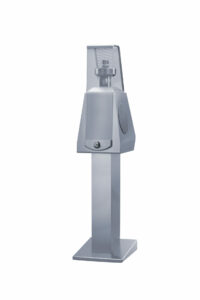
High Resolution Technologies Stage IV Loudspeaker/Amplifier System
$7000 (as reviewed)
And now for something else entirely different from ordinary speakers. The modular HRT Stage IV review system consisted of twelve mid/bass drivers (each channel!) arranged in a rectangle with a four tweeter sub-array running vertically down the approximate middle. (Four mid/basses in two columns to one side, eight to the other side in two columns of four. The system is modular, allowing you to choose the number of speaker modules.) This arrangement projects sound forward in a big way: Walk behind and the output almost vanishes over most of the frequency range. The system as reviewed was supplemented by a REL subwoofer. Like the Larsen Model 9s but via a different method, the Stage IV system really erases the listening room around you, leaving you immersed in the recorded acoustic environment. The system is subdued in the presence range: You might want to EQ presence up somewhat. But perceived distortion is very low, and the directional nature of the speakers puts you in the recorded space in a striking and very satisfying way. This is what high end is—or at least ought to be—all about. (The system is supplied with a pair of Sound Anchor stands, the Stage stereo amplifier, a REL S/3 subwoofer, and custom Furutech cables.)

Larsen Model 9 Loudspeaker
$14,995
The Model 9s are the most recent and, by a considerable margin, the best embodiment to date of the unusual but very effective design principles developed by designer John Larsen, based on and extending the earlier work of Stig Carlsson. Like other Larsen models, the Model 9 calls for placement against a long wall, some distance from either adjacent corner. The speaker has a wide dispersion pattern frontally, but the wall placement gives it “halfspace directivity” from the bottom up. The result is very close to a theoretical ideal of uniform response into the room, but with long-delayed first reflections since there is in effect no back wall reflection—the distance to the side walls makes those reflections also long delayed. This, combined with the high-quality drivers, makes the sound of the Model 9s truly remarkable. Especially when a slight prominence around 500-600Hz is removed with EQ, the overall response becomes very nearly neutral in a way that escapes speakers with highly variable radiation patterns. And the absence of early reflections makes the sound very precise. An instant classic.

Graham Audio LS5/9f Loudspeaker
$7995
The LS5/9f is in effect a floorstanding version of the stand-mounted Graham Audio LS5/9, itself a modernized iteration of the BBC LS5/9, and duly licensed by the BBC. Like the Graham LS5/9, the LS5/9f was designed by Derek Hughes, whose connection to BBC designs is lifelong (his father Spencer Hughes designed the Spendor BC1, which became the BBC LS3/6, back in the 1960s—we are looking at historic stuff here). The larger cabinet of the LS5/9f compared to the LS5/9 has made possible more bass extension with the same driver complement, enough extension that the LS5/9f now covers the orchestral bass range convincingly. The LS5/9f has a distinctive character, with a warm bass region generally and a somewhat rolled-off extreme top (my detailed review will go into why the former characteristic at least is very consonant with sounding like live music. A small prominence between 1kHz and 2kHz is easily dealt with.) The LS5/9f is best used away from side walls and/or with first side-wall reflections damped somewhat. With everything ideally arranged, the sound is remarkably like real music. The freedom from materials-based colorations, the thin-walled damped enclosure, the whole BBC engineering ethos as modernized by Derek Hughes are really faithful to the original intent of sounding not just like real music in general terms but specifically like the music that is actually recorded. This is not “audiophile sound” in the sense of lean low end and prominent top, but it has its own kind of truth, and, to my ears, a higher truth.

By Robert E. Greene
More articles from this editorRead Next From Review
See all
GoldenEar T66
- May 17, 2024

High-End Audio Buyer’s Guide 2024: MBL 126
- May 17, 2024

Burmester 175 Turntable
- May 14, 2024

DS Audio DS-W3 Optical Cartridge
- May 10, 2024


















